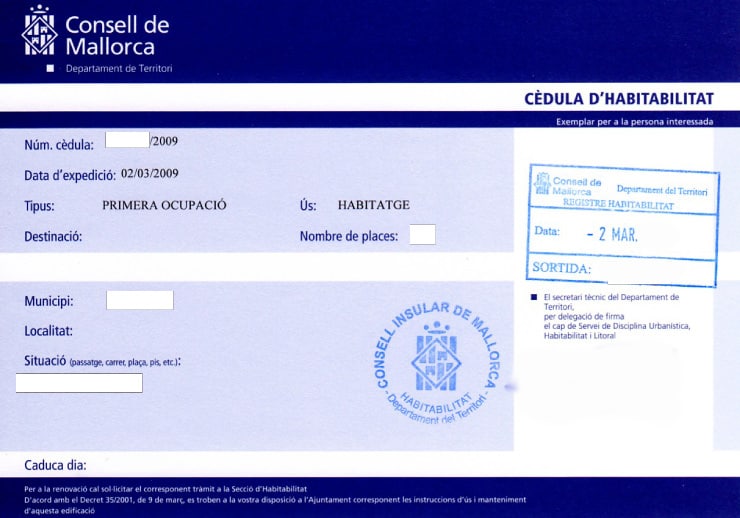What is the Cédula needed for?
What is the Cédula needed for?
The certificate of habitability, also known as the “cédula de habitabilidad”, is an official document issued by the Consell de Mallorca. It has a term of 10 years and serves as confirmation that a property meets the minimum requirements for a habitable living environment. These requirements relate to aspects such as size, technical equipment and sanitary facilities, which must meet certain specifications.
The certificate of habitability is nowadays a mandatory document when buying a property and, as a rule, a purchase cannot be completed without this certificate. Of course, there are exceptions to this rule. An example of this is if the buyer intends to demolish the acquired property and build something new or carry out a comprehensive core refurbishment. In such cases, the certificate of habitability may be waived.
It is important to be aware of the legal requirements and exemptions associated with the certificate of habitability to ensure that all necessary steps and regulations are followed when purchasing a property.

What types of Cédula de Habitabilidad are there?
There are three different types of cédula, which can be broken down as follows:
1. “Cédula de primera ocupación” – First occupancy certificate: This certificate is issued when a property has been completed for the first time or when extensive renovations, extensions or changes of use have been carried out. To obtain this certificate, plans and photographs of the property (signed by the architect), an extract from the land register and other documents must be submitted.
2. “Cédula de renovación” – renewal certificate: This certificate must be applied for every ten years. The application should be accompanied by proof of ownership, a recent photo of the property (dated and signed by the architect), a site plan with cadastral data and confirmation of habitability. In addition, proof should be provided that the structural condition of the property has not changed since the last cédula request. In practice, the extension is simply applied for without any major formal conditions.
3. “Cédula por carencia”: This certificate can be applied for if the property was built before March 1, 1987 and no cédula has been issued to date. This certificate is subject to a simplified procedure in the Balearic Islands: A document must be presented confirming that the building was completed before March 1, 1987, that there are no ongoing violations of building regulations in the municipality and that no structural changes have been made since March 1, 1987.
It is important to note that the Cédula has different requirements and procedures depending on the type and condition of the property. If you have any questions or uncertainties, it is advisable to consult a specialist or lawyer to ensure that all the necessary steps are carried out correctly.
What are the disadvantages of not having a Cédula de Habitabilidad?
The lack of a cédula can lead to some disadvantages. For example, you cannot conclude contracts for utility services with basic suppliers such as electricity, water, telephone and internet providers. However, in practice this is not always checked by the utility companies, and if you buy a property without a cédula, it usually already has all the necessary utilities, which can be taken over without any problems.
Another disadvantage of a missing cédula is that a possible mortgage for the purchase of the property can be refused. There are banks that may only provide a smaller loan if you do not have a cédula. It is therefore advisable to find out in advance about the banks’ specific requirements in order to avoid possible restrictions.
And anyone thinking about applying for a vacation rental license for their finca (perhaps possible again with the current government) will not be successful without a cédula.

